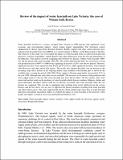| dc.contributor.author | Wawire, Noah W | |
| dc.contributor.author | Ochiel, Gerald R S | |
| dc.date.accessioned | 2015-11-11T11:55:57Z | |
| dc.date.available | 2015-11-11T11:55:57Z | |
| dc.date.issued | 2004 | |
| dc.identifier.citation | Review of the impact of water hyacinth on Lake Victoria: the case of Winam Gulf, Kenya. Noah W Wawire1 and Gerald R S Ochiel2 1.School of Environmental Studies, Moi University, P O Box 3900, Eldoret, Kenya 2.Kenya Agricultural Research Institute, National Fibre Research Centre, Kibos, P O Box 1490, Kisumu, Kenya Facsimile : +254 2 583344, Email:ochiel@swiftkisumu.com | en_US |
| dc.identifier.uri | http://hdl.handle.net/11671/798 | |
| dc.description.abstract | Water hyacinth, Eichhornia crassipes, invaded Lake Victoria in 1989 and has had significant social,
economic and environmental impacts, which remain largely unquantified. The biological control
administered by Kenya Agricultural Research Institute (KARI) coupled with other control measures have
reduced water hyacinth levels from 6000 ha to a current estimate of 400 ha., on the Kenyan Side of the lake.
The objective of this study was to document the impact of water hyacinth. Data was derived from personal
interviews with key respondents, Annual Reports and other publications from the relevant departments in
the Ministries. The analysis involved comparing data between two periods, without water hyacinth (1986-
91) and the period with water hyacinth (1992-99). The results indicated that there was an increase of total
fish production from 140597 to 168019 tons signalling an increase of 20% over the two periods. However,
significant increases were reported in Nile Perch and Prototerus, while significant decreases were realized
with Mormyrus and other mixed fish species. The results also showed that there was an increase in the
incoming cargo and a decline in the outgoing marine cargo handled at the Kisumu pier as shown by the
available data covering the period 1996-1998. Water supply to Kisumu municipality decreased by 25% in
the year 1999, although time series data was not available. The increases or decreases in fish production and
water supply points to the fact that water hyacinth may have had an effect. On the contrary, there were
mixed and unclear trends on the incidence of water hyacinth related diseases (malaria, bilharzia, cholera and
gastro-intenstinal disorders) which could not be directly associated with water hyacinth when the two
periods are compared. This was due to inadequate data resulting from recent subdivision in the various
districts and the fact that it was not easy to apportion the disease incidence resulting from water hyacinth
and other related causes. The study suggested the need to obtain reliable time series data on water hyacinth
infestation and initiate specialized studies to establish the impact of water hyacinth on bio-diversity, water
quality and supply, ecological succession and health and nutrition (343). | en_US |
| dc.language.iso | en | en_US |
| dc.publisher | Lake Victoria Environmental Management Project (LVEMP) | en_US |
| dc.subject | Water hyacinth | en_US |
| dc.subject | Impact | en_US |
| dc.subject | Fishery | en_US |
| dc.title | Review of the impact of water hyacinth on Lake Victoria: the case of Winam Gulf, Kenya. | en_US |
| dc.type | Article | en_US |

